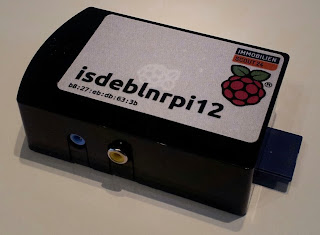Automated Raspbian Setup for Raspberry Pi
Update (2019): https://github.com/schlomo/rpi-image-creator is the new home of the code.
Recently we got a whole bunch of Raspberry Pi systems at work - the cheapest platform for building Dashboards.
Everybody loves those little cute boxes - but nobody wants to deal with the setup and maintenance. The kiosk-browser package is of course also the base of our Pi-based setup. But how does it get onto the Pi?
The solution is a Bash script: rpi-image-creator available on the ImmobilienScout24 GitHub project. It automates the setup of a Pi with Raspbian by downloading a Raspbian image, customizing it a bit and writing it to a SD card. The reason to write my own script where the following features:
Recently we got a whole bunch of Raspberry Pi systems at work - the cheapest platform for building Dashboards.
Everybody loves those little cute boxes - but nobody wants to deal with the setup and maintenance. The kiosk-browser package is of course also the base of our Pi-based setup. But how does it get onto the Pi?
The solution is a Bash script: rpi-image-creator available on the ImmobilienScout24 GitHub project. It automates the setup of a Pi with Raspbian by downloading a Raspbian image, customizing it a bit and writing it to a SD card. The reason to write my own script where the following features:
- It creates the file systems on the SD card instead of dumping a raw image onto the SD card. That way the partitions are all aligned properly and have the right size from the beginning. No later resizing needed
- It removes all the stuff that Raspbian runs at the first boot so that the resulting SD cards are production ready (IMHO the goal of any automation)
- It does some basic setup, adds my SSH keys, disables the password of the standard user
- It configures fully automated updates
- It adds our internal DEB repo with the internal GPG key and installs packages from there. In our case those packages do most of the customization work so that this script stays focused on the Pi-specific stuff
As a result I have now a one-step process that turns a fresh SD card into a ready system.
The script uses some tricks to do its work:
- Use qemu-arm-static to chroot into the Raspbian image on my Desktop. There are a whole load of other recipes on the Internet for doing that.
- Temporarily disable the optimized memcpy and memset functions in /etc/ld.so.preload as otherwise qemu-arm-static will just crash without a clear error message
- Mount the SD card file systems with aggressive caching to speed up writing to it. The ext4 filesystem is configured with the journal_data mount option to increase the resilience against sudden power losses
The script can be customized through a
rpi-image-creator.config file in the current directory:



Comments
Post a Comment